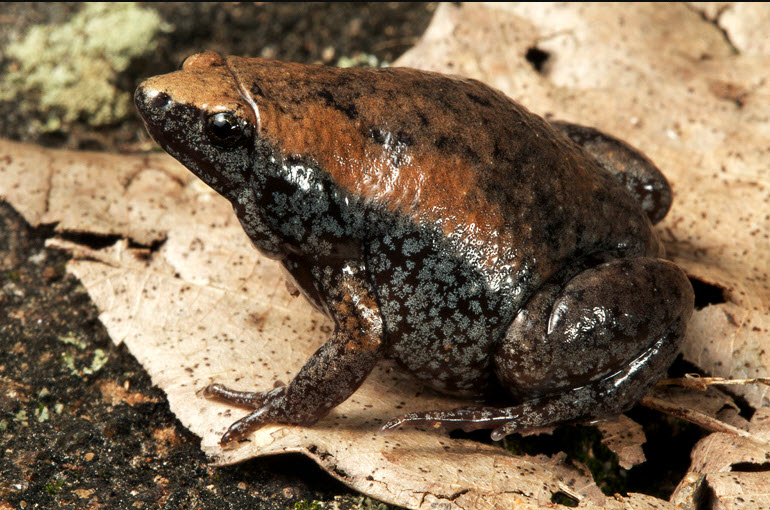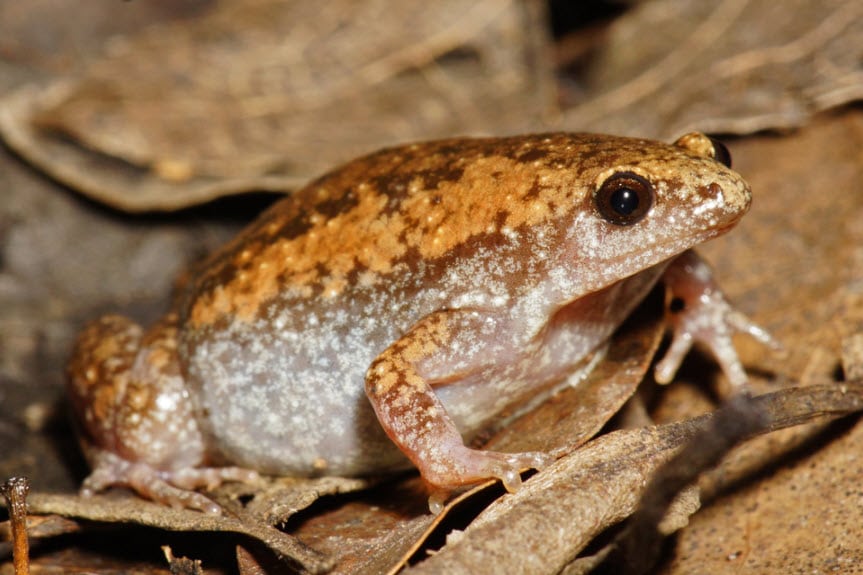
North Carolina is home to many amphibians, but unfortunately for all you Order Caudata fans out there, this article will not be about a salamander (our state is home to over 60 species, making it the place for salamander diversity in the world). No, today we are going to focus on the Eastern Narrow-mouthed toad. This small, somewhat tear-dropped shaped creature more closely resembles a frog: they have smooth, moist skin and lack warts. Their name comes from the tiny, inconspicuous mouth that they have on their small, pointy heads. Narrow-mouthed toads come in a variety of colors, ranging from gray to brown and reddish brown, but all tend to have a lighter-colored band along each side of their body. A fold of skin stretches across the back of their head, putting the finishing touch on these weird little toads.

Close-up photo of Gastrophryne carolinensis, Eastern Narrow-mouthed Toad, by Todd Pierson. Courtesy of Herps of NC
Small, plump, and nocturnal, these toads are often hard to spot in the wild, though their call, a nasally, lamb-like bleat, is distinctive. If you are in the Mountain or upper Piedmont regions of the Carolinas and Virginia, you probably will not hear them; but if you travel to the lower Piedmont and the Coastal Plain areas, there is a good chance you will start to hear their call beginning in April and continuing all the way into October. Narrow-mouthed toads (due to their, well, narrow mouths) cannot eat very large prey items. They can, and do, spend their nights feasting on small ants and termites, often being spotted near anthills, if they are spotted at all. Their skin secretions protect them from the ants and, as an added bonus, are also irritating to the eyes and mucous membranes of humans. During the day, these weird and wonderful animals stay put, hiding in moist areas under logs, leaf litter, and rocks.

Close-up photo by Kevin Stohlgren. Courtesy of Herps of NC.
Breeding for this species occurs from April through the fall on warm nights, usually during or after heavy rains. Narrow-mouthed toads tend to gather around temporary wetlands, such as ditches, puddles, and flooded fields. Black-and-white eggs are laid in packets on the water’s surface, with each packet containing around 850 eggs. Once they hatch, the tadpoles will metamorphose into tiny toads in anywhere from three to ten weeks. Narrow-mouthed toads are not an endangered or threatened species in North Carolina; however, they are vulnerable to the same pressures facing other amphibian species in the state. Protecting natural spaces where temporary pools of water can form will aid many amphibians. In order to ensure that the narrow-mouthed toad remains in existence for many years to come, we need to exercise good stewardship of the numerous wetland ecosystems found within our wonderfully species-diverse, amphibian-rich state.
